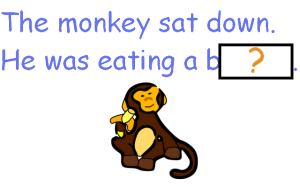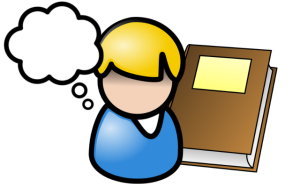What are reading strategies?

“Which strategy should I use…?”
Reading strategies are tools your child should be using to decode (work out) tricky/unknown words in a text. Competent readers have a number of strategies they are able to call on. These are also known as decoding strategies.
Print out this Reading Strategies Bookmark as a reference for your child. Make sure it’s close by for reference if needed. Have them refer to the bookmark to choose which strategy/ies to use. Visit our Comprehension Strategies page for more reading strategies.
1) Chunking
This strategy involves your child breaking words into manageable ‘chunks’ to sound out, rather than sounding out each individual letter.
For example in the word ‘stall’, your child should be able to recognise the blend ‘st-‘and identify its corresponding sound; ‘-all’ is the next chunk that can be used to help us solve the word: ‘st-all’,‘stall’. Another example is ‘shouted’ which could be broken down into the parts ‘sh-out-ed’
- The stronger your child is in word families and general letter/sound, the more successful they will be in using this strategy.
- Have your child look at the word to find letters combinations that they know. Once they have found one (or more), encourage the use of fingers to isolate the ‘chunks’.
2) What’s the First Sound?
In this strategy, the reader gets his/her lips ready to say the first sound, and tries to ‘pop’ it out. Often this strategy needs to be accompanied with ‘look at the pictures’. For example: The big d-d-d-dinosaur. Combining this strategy with ‘look at the pictures’ means the reader is having an educated guess.
- The house had a yellow door and big w….
- I went on a p… with my d… and mum. I at an a…
3) Look at the Pictures
As simple as it sounds! This strategy should be used with other strategies (ie. ‘What’s the first sound?’ strategy).
It is important to stress the need for children to have the confidence and ability to use more than one reading strategy to solve a word/words. This is particularly evident when using ‘Look at the Pictures’ strategy. When your child gets a clue from an illustration, encourage cross-checking using a second strategy.
For example:
“That looks like a sheep in the picture, now let’s check the word. What letters would the word have to start with? That’s right, ‘sh’. Does the word start with ‘sh’? No? It starts with an ‘L’. ‘L’ says ‘lll’. What word could it be? Let’s look back at the picture. It’s a l-l-lamb.”
4) Pre-Reading Strategies

Engage with the book before reading
These strategies aims to get children ready to read a book. We want to give children the best chance to be successful when reading a book, and these pre-reading strategies does just that. Before reading a book, have your child do a ‘walkthrough’ of the book.
While ‘walking through’ the book, get your child thinking about:
- What characters can I see?
- What is the setting of the story?
- What might the problem of the story be?
- How might the problem be solved?
Ask your child:
- What kind of book do you think this is? Is it a story? Or is it an information book? (introduce the terminology ‘fiction’ and ‘non-fiction’).
- Why do you think it’s a (fiction/non-fiction) book?
- What words do you think we will see in this book? (make a list of them- this will help when your child comes to reading those trickier words).
Before reading a text, it’s beneficial to have children activate their prior knowledge on a topic. The KWL chart organises this with 3 columns- ‘What I know’, ‘What I want to find out’ and (to use as a discussion after reading) ‘What I have learnt’.
5) Back Track and Read-On
When your child comes to an unknown word, they go back to the start of the sentence then re-read, skipping the word and reading on until the end of the sentence. This often helps as more information is presented and your child can make a considered ‘guess’ as to what the word may be. For example consider a child reading the following sentence and getting stuck:
The large bird… (unknown word)…
The large bird ‘something’ up to her nest.
We can see that the extra information provided by reading to the end of the sentence helps establish the missing word as ‘flew’.
The large bird flew up to her nest.
If your child is using multiple reading strategies, he/she will confirm the missing word by looking at the word and thinking “does the word start with a ‘fl’ sound?”
This strategy may need to be modelled many times before your child can use it successfully. It is sometimes necessary for you to read-on for them. For example, if they stop at a word and try to read on, but are having trouble/going too slow to make sense, read on out loud, to give them practice at using extra information to solve an unknown word. Eventually of course we want them to be able to do the whole process by themselves, but helping them achieve little successes along the way is key!
How to Teach These Reading Strategies
These 5 strategies must be taught explicitly. Focus on one strategy at a time. For each strategy:
- Explain: Talk to your child about it and explain what it means, how it’s used and when it’s useful.
- Model: When reading to your child, use the strategy ‘out loud’. Use the strategy as a competent reader to model what it should look/sound like.
- Support: Assist your child applying the strategy. Give feedback and make adjustments as needed.
- Independent: Your child should then be able to use the strategies independently. Continue to monitor the use.
Note:
- Find a step-by-step program for reading strategies here.
- If possible, choose texts that lend themselves to the strategy that you are focusing on. For example, flicking through a book before reading it with your child will let you know whether they will be able to make many meaningful connections.
- Also be sure to check out comprehension strategies which focus on helping children understand the book, rather than simply decoding the tricky words.
- Mask words in a book using post-it notes. You will need to go through and choose the suitable words to mask (1 or so per page). Different words will help your child practise different strategies.
- When your child stumbles upon a word and turns to you for help, help, but not by giving the word; help by asking “What can you do to work it out?”.
- If your child is unable to work out the word, ask “Is there another strategy you could try?”
- Reading strategies can and should be used in conjunction with one another. Each strategy presenting a hint about the word, when put together, it makes the word much easier to solve.
- Don’t feel you can’t ever tell your child a word (as our main goal, remember, is to foster a love of reading), just ensure you encourage independent attempts beforehand.







